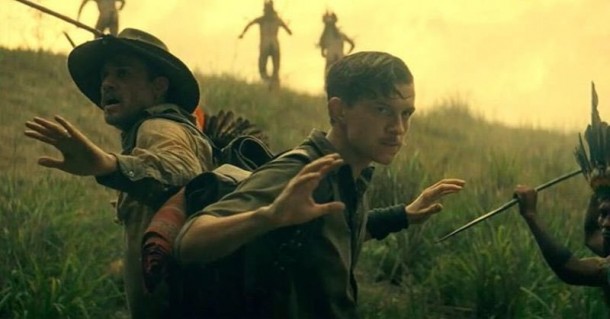
Dir: James Gray | Cast: Charlie Hunnam, Sienna Miller, Robert Pattinson, Angus Macfadyen, Tom Holland | US | 140 min.
Director James Gray, who based this biopic of Army officer/explorer Percival Fawcett on the non-fiction book by David Grann, delivers an un-ashamedly old-fashioned and linear boys-own-adventure, shot on grainy 35 mm, making The Lost City a stunning visual adventure spoilt by its overlong running time and regurgitation of the well documented stifling ideology of the Edwardian era which detracts substantially from the film’s enjoyment.
We first meet Major Percival Fawcett (Hunnam) in his late thirties, during a hunt staged for foreign dignitaries, where Fawcett distinguishes himself by killing a deer. But praise, in the form of an invitation for a formal dinner, will not come his way: his commanding officer explains, that “he choose the wrong ancestry” – meaning, that Percival’s father disgraced himself by alcoholism and gambling. But soon afterwards, there is a chance of redemption: The Royal Geological Society (RGS), of whom Percival’s father had been a member, offers Percival a tricky job in the Brazilian jungle where he has the thankless task of establishing a border between Brazil and Bolivia, rendered indistinct by newly installed profitable rubber plantations. Between 1906 and 1924 Fawcett would undertake seven more expeditions into the Brazilian jungle where he became obsessed by the idea of the lost city of Z, located somewhere in the Mato Grosso region of Brazil. Often clashing with James Murray (Macfadyen) an obese and unsuitable head of the rather reactionary RSG, who could not stomach the fact that the indigenous population had established a culture long before Great Britain, Fawcett is accompanied on all but his last trip by Henry Costin (Pattinson), who served him faithfully, backing him up in the dispute with Murray.
Fawcett joined the Army at the outbreak of WW1 in spite of his advanced age and he was injured and temporarily blinded at the battle of the Somme. His relationship with his wife Nina (Miller) was marked by his permanent absences: she had the burden of bringing up the children, whilst he followed his obsession. When Nina rebelled, wanting to accompany her husband on one of the expeditions (she was certainly fitter than Murray), Fawcett denied her vehemently, claiming “the different roles of males and females are the cornerstone of our culture”. In 1925 Fawcett made a final trip to the Brazilian jungle with his oldest son Jack (Holland): they were presumably killed by Indians along with around a hundred would-be-rescuers.
Percival Fawcett was a certainly a colourful character: he was befriended by Rider Haggard and Sir Arthur Conan Doyle, who used Fawcett’s exploits as material for his books: ‘The Lost World’. Fawcett was very much a one-dimensional man of his time: unable to settle down to family life, he searched for a holy grail, always preferring physical exhortations to reflective patience. He had an anti-authoritarian streak, in reaction to his father’s reputation, but was a male-chauvinist when it came to his relationship with Nina. James Gray (The Immigrant), reiterates the clichés of the era and Fawcett’s part in it over and over again, in a linear narrative that is as conventional and bloated as the characters themselves. A more contemporary approach, such as Pablo Lorrain’s deconstructed approach for Neruda, could have offered a tighter and more engaging watch, The overriding entertainment comes from DoP Darious Khondji (Amour, Seven) sumptuous jungle scenes, the opera house in the middle of the wilderness, the serenity of the natives and the attacking animals which are captured in magnificent lighting. Contrapuntal to the lush jungle landscapes, England is pictured as cold, artificial light dominates in the scenes shot at the RGS. The Lost City of Z is a visual masterpiece, if you can forgive the rather stolid narrative. AS
IN CINEMAS FROM FRIDAY 24 MARCH 2017